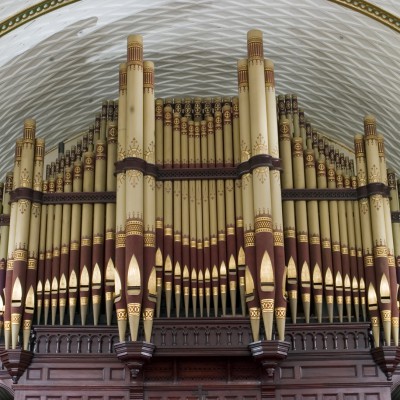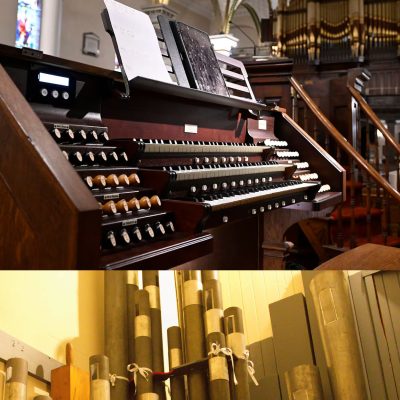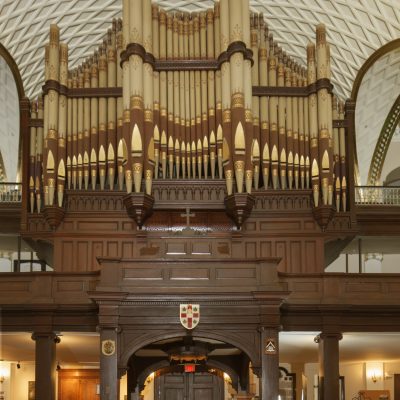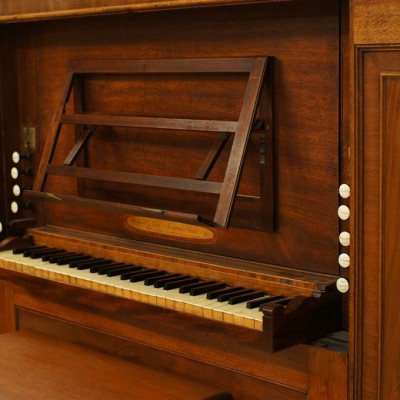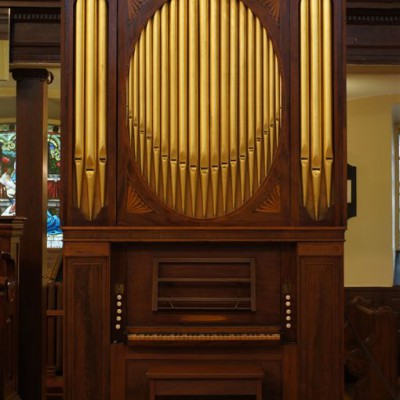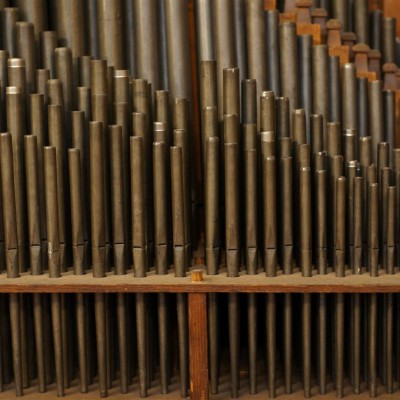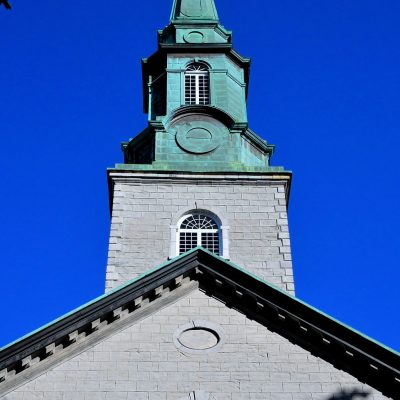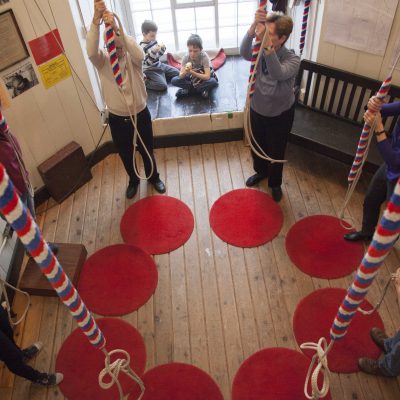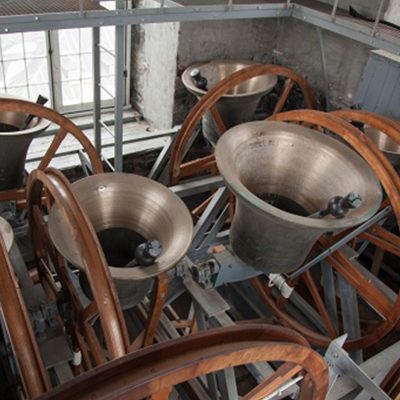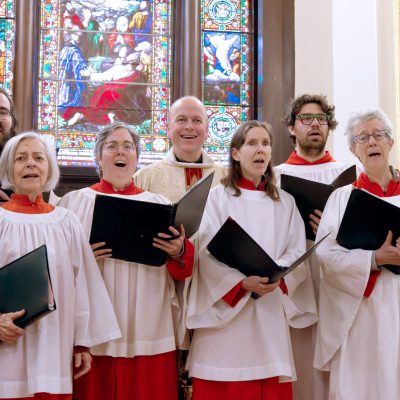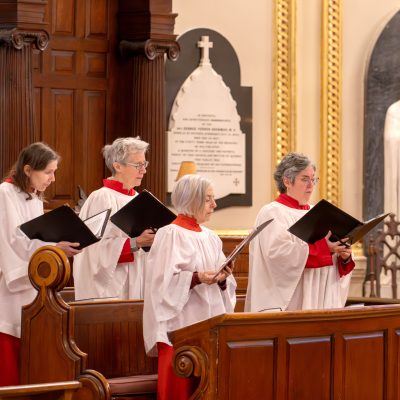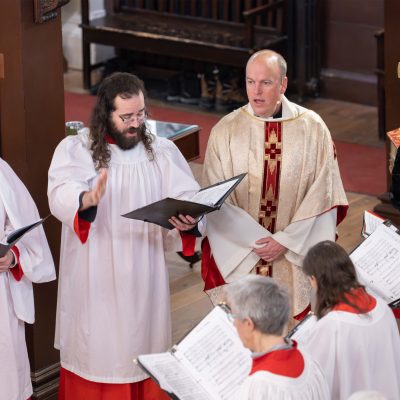The Gallery Organ
Warren, 1885 / Casavant, Opus 369, 1909 /
Hill, Norman & Beard, 1959
The current gallery organ at the Cathedral dates from 1885. The organ builder Warren of Montreal crafted an organ with 35 stops divided between 3 manuals and pedals, retaining only the organ case and façade pipes from the old instrument.
This Warren instrument was completely rebuilt by Casavant Frères in 1909. We decided to change it to an electro-pneumatic action. Most Warren stops were retained and the instrument was enlarged from 35 to 45 stops (50 stop knobs calling for some stops unification). The organ case was slightly enlarged on both sides and façade pipes were doubled with dummy display pipes.
In 1926, the console was moved to the front of the Cathedral.
In 1959, the firms of Wm Hill & Son and Norman & Bears were called upon for a new restoration. Apart from a new console, the only work done was on the pipework.The instrument has not been not enlarged except at the pedal, where stop unification is used even more, calling for adding portions of stops. The firms commented on the work as follows:
“External appearances remain unchanged and give no hint of the extensive changes within. The robust material of the original instrument has been meticulously restored to form a fine foundation for an imaginative and complete total remodelling.” (Hill, Norman & Beard, organ builders)
Source: http://www.musiqueorguequebec.ca/orgues/quebec/trinityq.html
The Chamber Organ
An historical organ was installed in the chancel in 2004 to celebrate the 200th anniversary of Holy Trinity Anglican Cathedral
The organ, built in 1790, was installed in 1811 by Sir William Bagshawe, a physician and a friend of Haydn, in his country house located in Oakes Park, in Yorkshire. It was located in an alcove in his dining room where it stayed until 1980. Bought by the Ontario collector and patron, Gordon Jeffery in an auction, the organ was reinstalled in London, Ontario. When Gordon Jeffery died in 1986, the Foundation responsible for disposing of all the instruments in his collection offered it to the city of Montreal, who accepted it and stored it in organ builder Hellmuth Wolff’s shop. Thanks to a large anonymous gift, the organ was purchased by Holy Trinity Anglican Cathedral in 2004 and restored by organ builders Wolff & Associates.
The organ was built by organ builders England & Son, specifically by Johan England and his son, George Pike England. There was a rich tradition of house organs in England before the mass arrival of the pianoforte. Many wealthy families had these polyvalent instruments in their houses which were fitted out by cabinetmakers in the style of the day. Thanks to this tradition, many instruments have come down to us unchanged.
The stoplist is as follows:
Two 8′ stops: the Open Diapason from the second C to the treble F, and the Stopped Diapason, divided into Bass (from the first G to central B) and Treble (from central C to treble F). These two stops are the foundations of the organ and are used in almost every registration.
A 4′ stop: Principal, also divided into Bass and Treble, and a 2′ stop, the Fifteenth. These stops, with the 8′ stops, are the plenum of the organ.
Three 8′ solo stops, from the central C: the Hautboy, reed stop located in its own expressive box; the Dulciana, and the Cornet III (2 2/3, 2, 1 3/5). The latter being compled, in the bass, by the Sesquialtera III that can be added to the plenum.
Three iron pedals are available to the organist. The one in the middle is used to occasionally pump the instrument (it is a very tough job); the one on the right opens and closes the expressive box containing the hautboy, the one on the left is used to cancel (if they are drawn) all stops over 8′, this allows the player to quickly switch from piano to forte.
Benjamin Waterhouse
The Cathedral’s bells date from 1830 and are the oldest change-ringing bells in Canada. They were cast by “Thomas Mears II” which eventually became “Whitechapel Bell Foundry” in London, England, the same foundry that cast Big Ben, the Liberty Bell in Philadelphia, and the great bell “Jean-Baptiste” of Notre-Dame Basilica in Montreal. The Whitechapel Foundry (and its predecessors) has been making bells in the same foundry for centuries, and indeed is the oldest manufacturing company in the United Kingdom.
English change-ringing bells, which are rung in elaborate, changing sequences, are quite rare in Canada. In the whole country there are only seven bell towers with change-ringing bells. Quebec is the only city in Canada that has two change-ringing towers: that of our Cathedral and that of the former St. Matthew’s Church, now the succursal Saint-Jean-Baptiste of the Bibliothèque de Québec. The former St. Matthew’s Church was sold by the Anglican Diocese of Quebec for one dollar to the City of Quebec, in 1979, so that it could be converted into a library.
The Cathedral of the Holy Trinity has eight bells in its tower. The heaviest, the tenor, weighs 721 kg (1591 lbs.), while the lightest, the treble, weighs 297 kg (545 lbs.). A team of eight ringers is required to ring all eight bells in sequence. The Quebec City Guild of Change Ringers is probably the only bilingual (French-English) change-ringing team in the world, and has already had two French-speaking leaders, or tower captains. It includes male and female members, and the ages of the ringers ranges from 9 to 80+ years. Over the years the City of Quebec has asked the change ringers from the Cathedral to ring the bells on such special occasions as Christmas, New Year’s Day, Saint-Jean-Baptiste Day and on the anniversary of the day of the founding of Quebec City. The two Quebec City towers have also been visited on a number of
occasions by special delegations of bell ringers from the United States, England, Scotland, Ireland, Wales and Australia.
In 2006, the Cathedral of the Holy Trinity Foundation undertook the major project of a full restoration of the Cathedral’s great peal of eight English change ringing bells.
In 2006, the Cathedral of the Holy Trinity Foundation undertook the major project of a full restoration of the Cathedral’s great peal of eight English change ringing bells. The Whitechapel Bell Foundry trimmed off hundreds of pounds of metal from the bells in order to retune them.
An interesting exchange of emails between Whitechapel and our Cathedral Organist, Dr. Benjamin Waterhouse, led to the final decision on the approach preferred for tuning the bells.
For information on joining the The Quebec City Guild of Change Ringers?
Join Us
Here is the Whitechapel Bell Foundery summation:
I note and agree that the precise keynote is unimportant and does not need to coincide with that of the organ. On the basis of the tuning figures that we have now established, we propose flattening the bells such that the tenor will have a strike note a little sharp of E International Pitch.
As far as the temperament is concerned, we propose working to 5thcommon mean tone, as this produces a musical, but not modern sound with individual keynote tone colours.
As far as the internal tuning is concerned we will firstly “skirt” the bells (machine flat seatings upon the lips to remove the chips and provide a flat surface to work to when we fit the headstocks) and then flatten the hum notes so that we provide an even hum note to strike note relationship across the range whilst at the same time minimise any flattening to the 2nd partials. This work will produce a slightly richer sound and will also cause the bells to sound as a single instrument rather than a series of individual bells all slightly different.
It seems to me that we have now explained our approach which coincides with your organist’s concerns. On that basis we propose commencing tuning next week unless you wish us not to pending any further queries or input.
Yours sincerely
Whitechapel Bell Foundry Limited
Sing to the Lord, all the earth! Sing of His glorious name! Tell the world how wonderful He is.
Psalm 66:1-2
Choral music is an important part of the Anglican tradition, and our choir serves to beautify the liturgy with music. The choir is part of Sunday worship every week, sings on special days during Christmas, Easter and Holy Week, as well as during the new quarterly Evensong services now held at the Cathedral.
Our choir currently includes ten chorists who sing different types of sacred music from the ecclesiastical choral repertoire, from medieval to modern. We are always looking for new voices: come join the group!
Dr. Benjamin Waterhouse
Organist
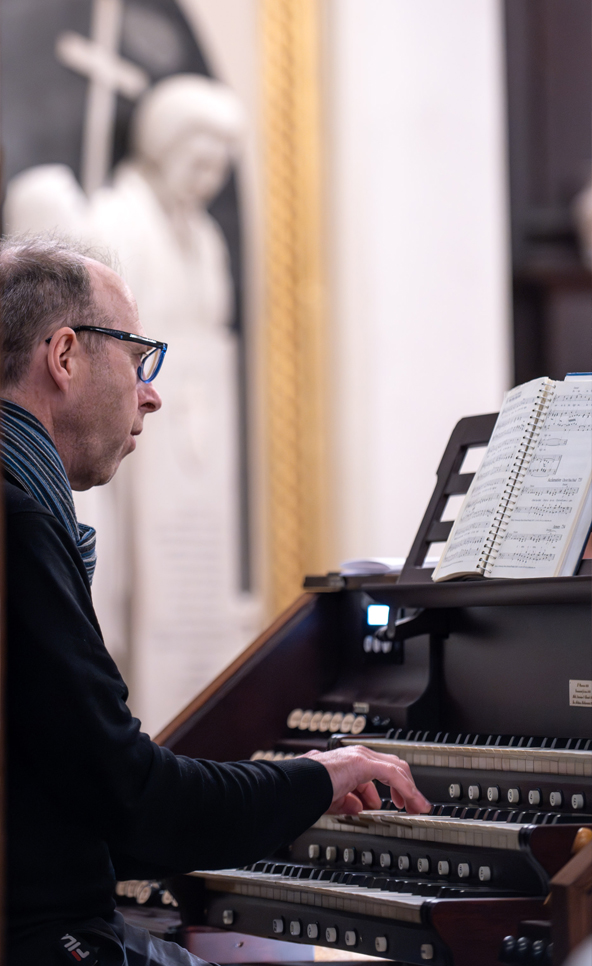
Born in England in 1961, Benjamin Waterhouse has been the organist of the Cathedral of the Holy Trinity since 2000. He began to play the organ as a chorister in England, before continuing his studies in Québec and France. He completed a doctorate in 1990, looking at the question of harmonic rhythm in the organ music of J.S. Bach, and has released two previous CDs, one featuring music by Elgar and Debussy, and the other two organ symphonies by Charles-Marie Widor.
Before being appointed titular organist at the Holy Trinity Anglican Cathedral in Québec City, he was organist at St. Andrew’s Presbyterian Church, in Québec City.
Antoine Trépanier
Choirmaster
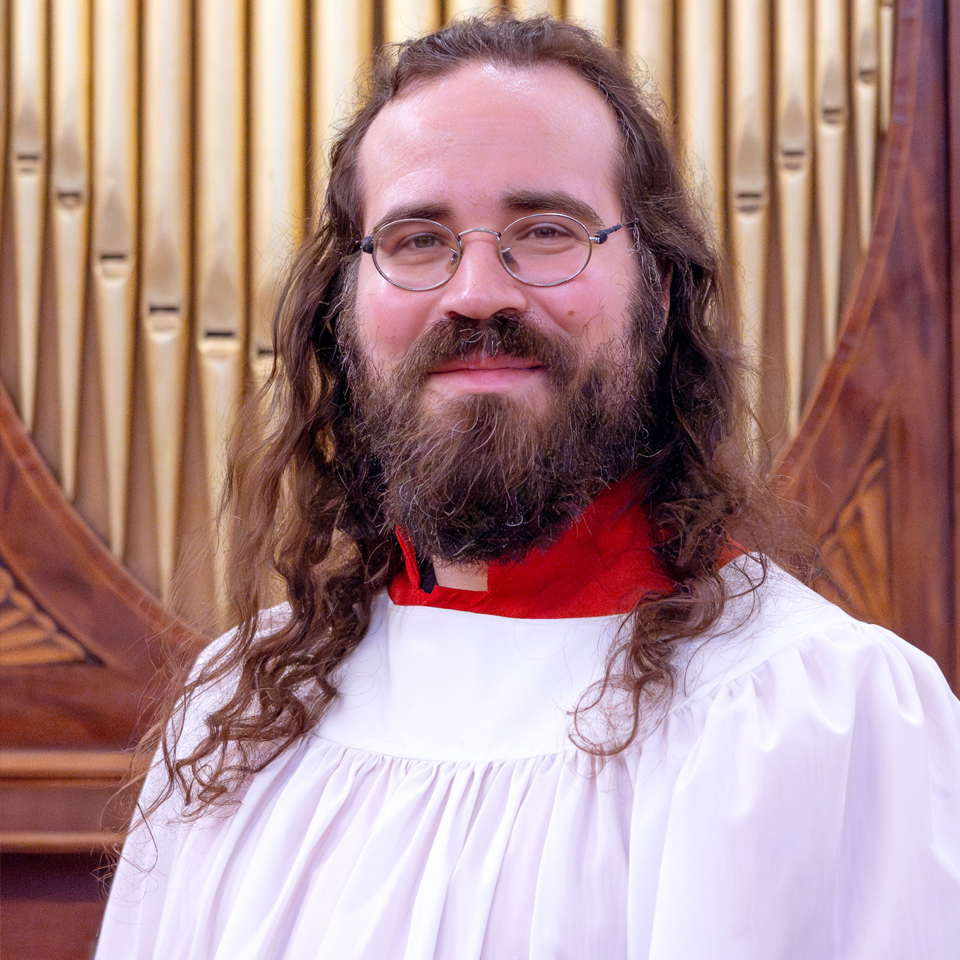
From an early age, Antoine Trépanier showed a keen interest in music and composition. He began studying classical piano at the age of 6, then took up the bassoon when he entered high school. Having studied bassoon and composition at the Conservatoire de Musique de Québec and Université Laval, he has been working as a bassoonist, lamist, recorder player, singer, teacher and composer in the Quebec City region. He performs regularly as a bassoonist with various orchestras in the province of Quebec.
He has been the Choirmaster at Holy Trinity Cathedral since 2018. Parishioners and visitors to the Cathedral have enjoyed his musical talents and choice of repertoire for many years now.
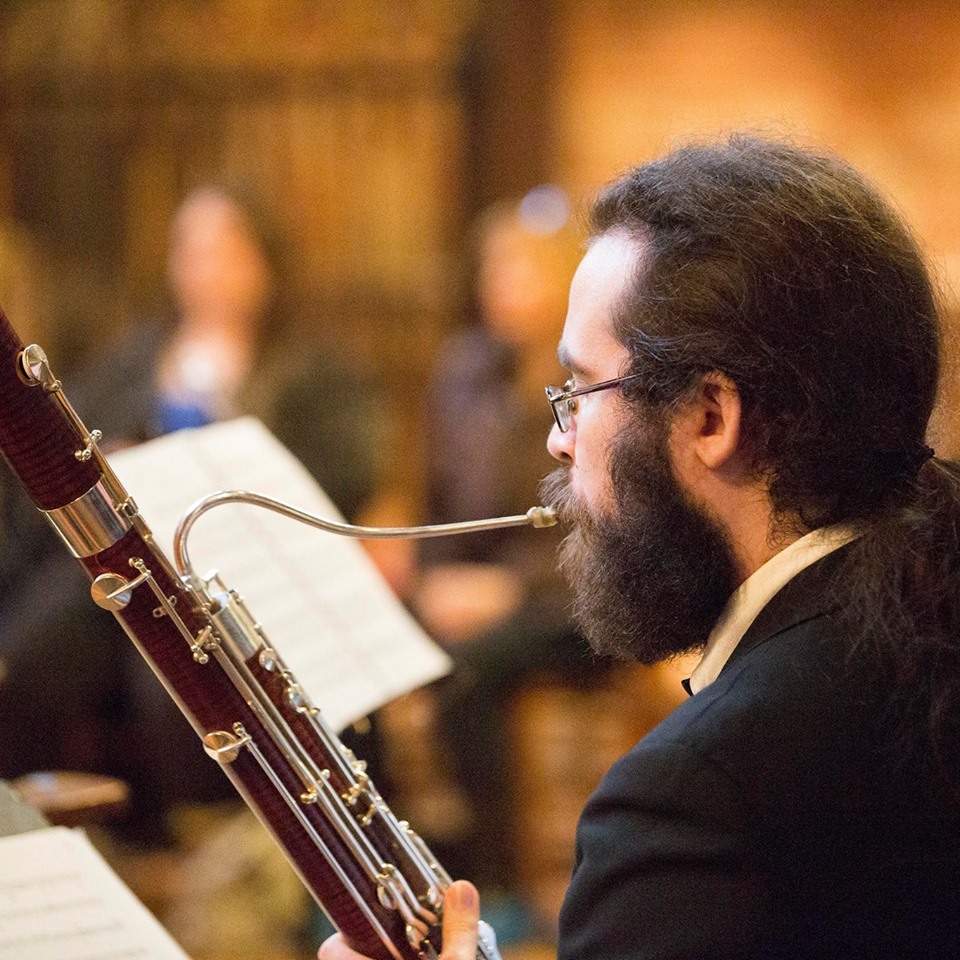
The anglican community of the Cathedral of the Holy Trinity is the principal representative in Quebec City of a rich religious and musical tradition developed in England and still alive in this country. Music in the Cathedral is not limited to religious celebrations. Throughout the year, the Cathedral hosts many concerts.
Midi en musique
The concert series will return this summer. Every Thursday noon from July 6 to August 24, 2023. Watch for the release of the program in May.
Recordings
The Cathedral of the Holy Trinity has one of the best acoustic in Quebec and is an exceptional place for audio and video recordings . Please contact the Cathedral for more information .
Concerts
Several concerts are scheduled this spring. Check the calendar and join us for a divine moment of relaxation.


